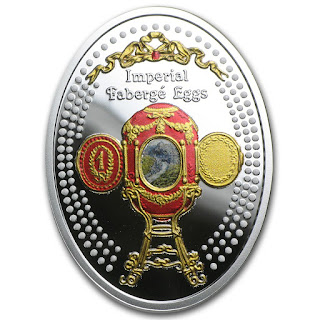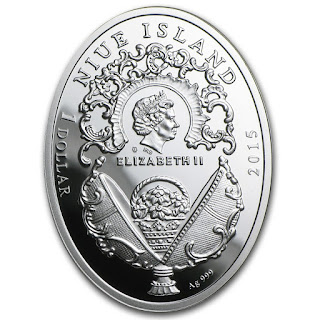Niue 1 Dollar Silver Coin 2015 Caucasus Egg - Imperial Faberge Eggs
Series: Imperial Fabergé Eggs
Obverse: At the bottom – open „Spring Flowers Egg” (1899-1903) with a miniature basket and a bouquet of anemones. Above the basket – the effigy of Her Majesty Queen Elizabeth II with an inscription: ELIZABETH II and the mint mark (m/w). Around – a decorative, neo-rococo ornament. Along the rim – the issuer’s name: NIUE ISLAND, the face value: 1 DOLLAR, the hallmark (Ag 925) and the year of issue – 2015.
Reverse: In the foreground you will see an image of the magnificent Caucasus Egg with colored and 24-carat gold plated elements. The image depicts the original egg with its four fringed doors opened revealing the miniature watercolors depicting landscapes of the Caucasus.
The Caucasus Egg is a jewelled enameled Easter egg made by Michael Perkhin under the supervision of the Russian jeweller Peter Carl Fabergé in 1893. The egg was made for Alexander III of Russia, who presented it to his wife, the Empress Maria Feodorovna. Currently the egg is a long term installation at the Metropolitan Museum of Art in New York City, New York, as part of the Matilda Geddings Gray Foundation.
Year of Issue: 2015.
Metal: Silver.
Silver Fineness: Ag 925/1000.
Content: 0.54 Troy OZ.
Denomination: 1 NZD - legal tender in New Zealand.
Weight: 16.81 g.
Diameter: Ellipse 39 x 29.20 mm.
Quality: Proof coin with Gold Gilding on it.
Mintage of only 1,999 coins.
Exterior Decoration: Zircons and Elements in Polished Finish.
Producer: Mint of Poland (Mennica Polska).
Series: Imperial Fabergé Eggs
Third Imperial Egg 1887 Faberge Caucasus Egg 1893 Faberge
Caucasus Egg - Faberge Eggs
The Caucasus Egg is a jewelled enameled Easter egg made by Michael Perkhin under the supervision of the Russian jeweller Peter Carl Fabergé in 1893. The egg was made for Alexander III of Russia, who presented it to his wife, the Empress Maria Feodorovna.
Currently the egg is a long term installation at the Metropolitan Museum of Art in New York City, New York, as part of the Matilda Geddings Gray Foundation.
The Egg
The egg is made of yellow and varicoloured gold, silver, ruby enamel, rose-cut diamonds, portrait diamonds, platinum, ivory, pearls, rock crystal and watercolour on ivory.
It commemorates Abastumani in Caucasus where Grand Duke George spent most of his life after being diagnosed with tuberculosis. Miniatures were done and signed by Krijitski. The miniatures are revealed by opening four pearl-bordered doors around the egg. Each door bears a diamond-set numeral of the year, forming the year 1893. Behind the hinged cover at the top is a portrait of the Grand Duke in his naval uniform.
This is the first Imperial egg known to be dated. Ruby red enamel was used only one other time for the Imperial eggs as Alexei's hemophilia was a constant worry for the family.
Surprise
The surprise for this egg are the miniature paintings themselves.

